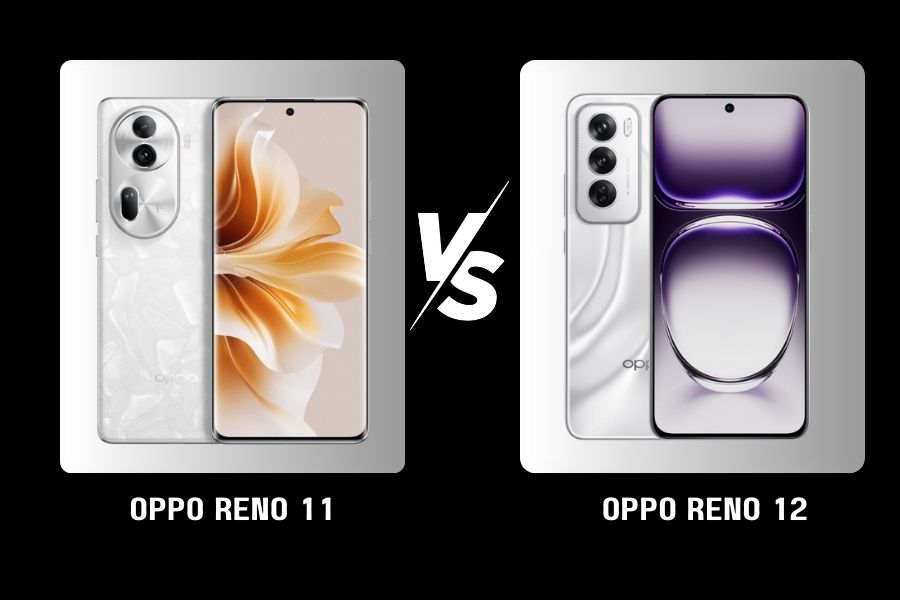Oppo‘s Reno series occupies a crowded space in the smartphone market: the ever-competitive mid-range. With the recent launch of the Reno 12, it’s natural to wonder how it stacks up against its predecessor, the Reno 11. So here we will take a close look at both models to see if the upgrade is worth considering.

Display
Both phones feature a near-identical 6.7-inch AMOLED displays with 120Hz refresh rates and 1080p resolution. Bezels are minimal, offering a near edge-to-edge viewing experience. In terms of raw specs, there’s little to differentiate between the two.

However, the Reno 12 boasts a slight bump in peak brightness, reaching 1200 nits compared to the Reno 11’s 950 nits. This could offer a minor improvement in outdoor visibility.
Additionally, the Reno 12 introduces a quad-curved display for a more premium look and feel, while the Reno 11 only has curves just on the sides. The Reno 12 also comes with Gorilla Victus 2, which the Reno 11 lacks.
Performance
Under the hood, the Oppo Reno 12 edges out its predecessor with the MediaTek Dimensity 8250 chipset compared to the Reno 11’s Dimensity 8200. While both are built on the same 4nm process, the 8250 offers a marginally higher clock speed.
In day-to-day use, the performance difference is unlikely to be noticeable for most users. Both phones are capable of handling most tasks and games without issue. However, power users who prioritize raw processing power may want to look elsewhere since these are not the SoCs for heavy gaming.
Both phones come in a similar selection of storage configurations (256GB and 512GB) but differ in RAM options. The Reno 12 offers a top-end model with up to 16GB RAM option while the Reno 11 maxes out at 12GB, which is still ample for most users.
Both phones lack expandable storage via microSD card, so choosing the right storage capacity from the outset is crucial.
Software
Both the devices come pre-installed with Android 14 but the Reno 12 has newer Color OS 14.1 compared to Color OS 14 on Reno 11. While there’s not a major difference in the UI and usability, 14.1 brings a hunch of AI features. Of course, 2024 is the year of AI.
These include fixing photos where someone blinked, removing people who walked into the frame, and helping you replace backgrounds.
There’s also transcription and summarization of dictations and a document scanner that can handle tricky tasks like math formulas. The phone’s Xiaobu assistant can also act as an English teacher and a primary school tutor. Moreover, the AI can help plan your next vacation and create a custom itinerary.
These features should eventually be available on the Reno 11 through a software update.
Cameras
The camera systems on both phones are triple, but the configuration differs slightly. The Reno 12 ditches the 32MP telephoto of the Reno 11 for a 50MP telephoto lens. The main and ultrawide sensors remain the same at 50MP and 8MP, respectively.

On paper, this appears to be an upgrade that should capture better zoom shots. However, it’s the real-world testing that will help us understand if the megapixel boost translates to an improvement in image quality.
The selfie camera on the Reno 12 also receives an upgrade to a 50MP sensor from the 32MP unit on the Reno 11.
Battery Life and Charging
The Oppo Reno 12 boasts a larger 5000mAh battery compared to the Reno 11’s 4800mAh. While the difference may seem small, it could translate to slightly longer battery life for the Reno 12, especially for heavy users.
Both phones offer fast charging, but the Reno 12 takes the lead with its 80W wired charging compared to the Reno 11’s 67W. This translates to potentially faster charging times for the Reno 12.
Design and Others
The design language between the two phones is similar, with both sporting sleek glass backs and minimal bezels. However, the Reno 12 boasts an IP65 dust and water resistance rating.
Reno 11 misses on any sort of IP rating. It could be a deciding factor for users who require a phone that can withstand the occasional splash. For audio, they come with a single speaker and miss the 3.5mm headphone jack.
Conclusion
The Oppo Reno 12 offers modest upgrades over the Reno 11 in specific areas – a marginally better processor, a higher-res main and telephoto lens, a larger battery, faster charging, and better ingress protection. These improvements alone may not be game-changing for all users, especially those content with the Reno 11’s performance.
However, for those seeking the latest features and a slight edge in battery life and camera capabilities, the Reno 12 could be a compelling choice.
Ultimately, the decision depends on individual needs and budget. If you can find a good deal on the Reno 11, it may still offer excellent value for the price. But if you crave the newest features and are willing to pay a premium, the Reno 12 might be the better bet.
Below is a quick rundown of the specifications:
| Feature | Oppo Reno 11 | Oppo Reno 12 |
| Body | 162.4 x 74.1 x 7.6 mm, 184 g | 161.4 x 74.8 x 7.3 mm, 179 g |
| Water Resistance | No | IP65 |
| Display | 6.7 inch AMOLED, 1080 x 2412 pixels, 120Hz | 6.7 inch AMOLED, 1080 x 2412 pixels, 120Hz |
| Peak Brightness | 950 nits | 1200 nits |
| Display Protection | None | Corning Gorilla Glass Victus 2 |
| Processor | Mediatek Dimensity 8200 | Mediatek Dimensity 8250 |
| RAM | 8GB, 12GB | 12GB, 16GB |
| Storage | 256GB, 512GB | 256GB, 512GB |
| Rear Camera | Triple: 50MP main, 32MP telephoto, 8MP ultrawide | Triple: 50MP main, 50MP telephoto, 8MP ultrawide |
| Front Camera | 32MP | 50MP |
| Battery | 4800 mAh, 67W charging | 5000 mAh, 80W charging |
Related:
- OPPO Enco R3 With AirPods-Like Design, Spatial Sound Effects Launched In China
- OPPO Pad Air 2 Aurora Purple Color Variant Announced In China
- Oppo launches Enco Air 4 Pro earbuds with 49dB noise cancellation, 44 hours battery life
- Oppo Find N5 Foldable could launch in Q1 2025 with Snapdragon 8 Gen 4
- Get $100 OFF on Xiaomi 14 Pro at Giztop (1TB Variant)
- Lenovo Legion Y700 2024: Latest Gaming Tablet with Enhanced Display now available at Giztop
- REDMAGIC Magnetic VC Cooler 5 Pro now available at a discounted price at GeekWills






